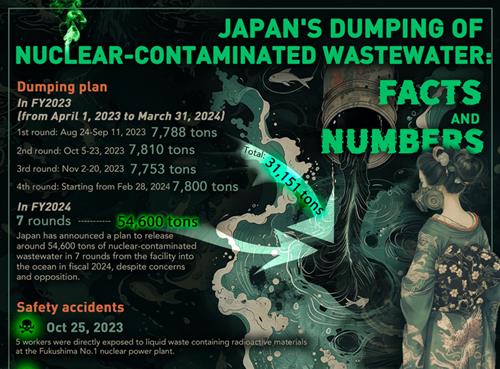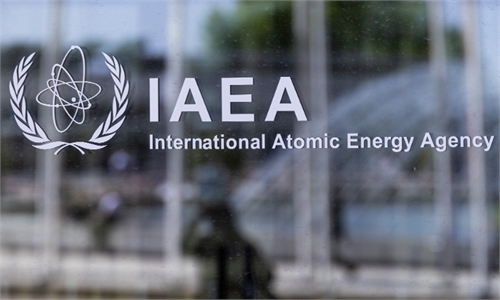Japanese media report misleading, Fukushima’s nuclear-contaminated wastewater harmful

Japan's reckless dumping of nuclear wastewater poses a grave danger to Earth. Cartoon: Carlos Latuff
Recently, a Japanese media outlet reported that the tritium content in the liquid effluent discharged by Chinese nuclear power plants far exceeds the annual emission limit of tritium in nuclear-contaminated wastewater from Fukushima. The Chinese Ministry of Foreign Affairs pointed out on March 12 that the nuclear-contaminated water produced in the Fukushima accident is in nature different from the liquid effluent from normally functioning nuclear power plants, and they could not be put in the same category. The report focuses solely on tritium, attempting to create the false impression that nuclear-contaminated wastewater from Fukushima only contains tritium and demanding that the relevant media outlets stop such unprofessional and irresponsible reporting.Several authoritative experts have stated that nuclear-contaminated wastewater from Fukushima and the normal discharge of nuclear power plants are fundamentally different and cannot be compared. It is not the first time that the Japanese media outlets have deliberately mixed the two and misled public perception. This misleading statement stems from a public relations campaign initiated by the Japanese government, aiming to create a false impression of the "safety" and "reliability" of nuclear-contaminated wastewater from Fukushima by comparing the tritium content with the tritium discharge from normal nuclear power plant discharge. Nuclear-contaminated wastewater from Fukushima and the normal discharge of nuclear power plants has different sources, different types of radioactive nuclides and different levels of difficulty in treatment. Moreover, there are fundamental differences between them.
In terms of sources, nuclear-contaminated wastewater from Fukushima comes from the cooling water injected into the melted and damaged reactors core after the highest-level nuclear accident in history, as well as groundwater and rainwater flowing through the reactor, containing various radioactive nuclides present in the core. The liquid effluent discharged from nuclear power plants in various countries does not come into direct contact with the reactor core. These are normal operational discharges and follow international standards.
In terms of types of radioactive nuclides, nuclear-contaminated wastewater from Fukushima contains dozens of radioactive nuclides. In addition to tritium, it also includes strontium-90, cesium-137, iodine-129, plutonium-239 and other transuranic nuclides with high toxicity. The Japanese side has always unilaterally emphasized that the annual emission of tritium in nuclear-contaminated water is very small. They say this just to mislead the public and divert attention. What should be of more concern are other radioactive nuclides that are more harmful than tritium. Some Japanese experts have pointed out that the radiation risk of radioactive substances cannot be completely ignored, cesium can affect the thyroid, and strontium can invade the bones. In comparison, the normal discharge of nuclear power plants does not come into direct contact with the nuclear fuel core and contains far fewer types of nuclides.
The different types of radioactive nuclides determine the difficulty of treatment. Japan has designed a multi-nuclide treatment system specifically for dealing with nuclear-contaminated wastewater from Fukushima, but its effectiveness and long-term reliability have not been certified by third-party authorities. In contrast, nuclear power plants in various countries have mature and reliable treatment systems for normal operation discharge, strictly adhere to international standards, use the best available technologies for treatment and are discharged in an organized manner after rigorous monitoring to meet the specified control values. Decades of operation of nuclear power plants in various countries have also proven to be safe and controllable.
China's management of tritium emissions from nuclear power plants has always been strict and in line with international practices, and the emission levels are comparable to those of mainstream nuclear power plants around the world. For example, the Genkai Nuclear Power Station in Japan had a total of 71 trillion becquerels in 2020. If the Japanese media tries to hype the issue of tritium emissions in order to discredit China's management of nuclear power plants and pressure the Chinese government to stop opposing the dumping of nuclear-contaminated wastewater from Fukushima into the sea, they will never succeed.
China opposes the dumping of nuclear-contaminated wastewater into the sea but has never opposed the normal discharge of nuclear power plants in various countries, including Japan. The Japanese media's attempt to confuse the issue under the guise of science, and unscientific and unprofessional conclusions, cannot deceive the world. In fact, this only highlights the Japanese side's lack of justification and guilt in the issue of dumping nuclear-contaminated wastewater from Fukushima into the sea. After all, no matter how the Japanese media outlets whitewash the issue of contaminated water, it cannot turn it into normal discharge, nor can it change the fact that dumping nuclear-contaminated wastewater into the sea is improper, unreasonable and illegal. In the case of nuclear-contaminated wastewater from Fukushima, which is a major issue concerning public health and marine ecology, respecting science and facts should be the minimum professional ethics for news media.
The author is an observer on international affairs. opinion@globaltimes.com.cn


